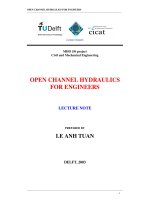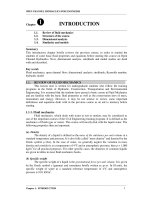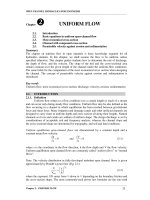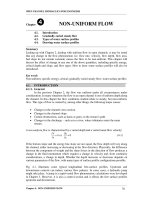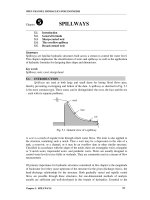matlab books - essentials for engineers & scientists - brian d. hahn & daniel t. valentine
Bạn đang xem bản rút gọn của tài liệu. Xem và tải ngay bản đầy đủ của tài liệu tại đây (7.25 MB, 449 trang )
Prelims-H8417 6/1/2007 15: 53 page i
Essential MATLAB® for Engineers and Scientists
Prelims-H8417 6/1/2007 15: 53 page ii
Reviewers’ Quotes
This book provides an excellent initiation into programming in MATLAB while serving as a
teaser for more advanced topics. It provides a structured entry into MATLAB programming
through well designed exercises.
Carl H. Sondergeld
Professor and Curtis Mewbourne Chair
Mewbourne School of Petroleum and Geological Engineering
University of Oklahoma
This updated version continues to provide beginners with the essentials of Matlab, with many
examples from science and engineering, written in an informal and accessible style. The new
chapter on algorithm development and program design provides an excellent introduction to a
structured approach to problem solving and the use of MATLAB as a programming language.
Professor Gary Ford
Department of Electrical and Computer Engineering
University of California, Davis
For a while I have been searching for a good MATLAB text for a graduate course on methods
in environmental sciences. I finally settled on Hahn and Valentine because it provides the
balance I need regarding ease of use and relevance of material and examples.
Professor Wayne M. Getz
Department Environmental Science Policy & Management
University of California at Berkeley
This book is an outstanding introductory text for teaching mathematics, engineering, and
science students how MATLAB can be used to solve mathematical problems. Its intuitive
and well-chosen examples nicely bridge the gap between prototypical mathematical models
and how MATLAB can be used to evaluate these models. The author does a superior job of
examining and explaining the MATLAB code used to solve the problems presented.
Professor Mark E. Cawood
Department of Mathematical Sciences
Clemson University
Prelims-H8417 6/1/2007 15: 53 page iii
Essential MATLAB®
for
Engineers and Scientists
Third edition
Brian D. Hahn
and
Daniel T. Valentine
AMSTERDAM • BOSTON • HEIDELBERG • LONDON • NEW YORK • OXFORD
PARIS • SAN DIEGO • SAN FRANCISCO • SINGAPORE • SYDNEY • TOKYO
Butterworth-Heinemann is an imprint of Elsevier
Prelims-H8417 6/1/2007 15: 53 page iv
Butterworth-Heinemann is an imprint of Elsevier
Linacre House, Jordan Hill, Oxford, OX2 8DP
30 Corporate Drive, Burlington, MA 01803
First published 2002
Reprinted 2002, 2003, 2004, 2005, 2006
Second edition 2006
Third edition 2007
Copyright © 2002, 2006, 2007 Brian D. Hahn and Daniel T. Valentine. Published by Elsevier Ltd. All rights reserved
The right of Brian D. Hahn and Daniel T. Valentine to be identified as the authors of this work has been asserted in
accordance with the Copyright, Designs and Patents Act 1988
No part of this publication may be reproduced, stored in a retrieval system or transmitted in any form or by any
means electronic, mechanical, photocopying, recording or otherwise without the prior written permission of the
publisher
Permission may be sought directly from Elsevier’s Science & Technology Rights Department
in Oxford, UK: phone (+44) (0) 1865 843830; fax (+44) (0) 1865 853333; email:
Alternatively you can submit your request online by visiting the Elsevier web site at
and selecting Obtaining permission to use Elsevier material
Notice
No responsibility is assumed by the publisher for any injury and/or damage to persons or property as a matter of
products liability, negligence or otherwise, or from any use or operation of any methods, products, instructions or
ideas contained in the material herein. Because of rapid advances in the medical sciences, in particular,
independent verification of diagnoses and drug dosages should be made
British Library Cataloguing in Publication Data
A catalogue record for this book is available from the British Library
Library of Congress Cataloging-in-Publication Data
A catalog record for this book is available from the Library of Congress
ISBN 13: 9-78-0-75-068417-0
ISBN 10: 0-75-068417-8
For information on all Butterworth-Heinemann publications visit our
web site at books.elsevier.com
Typeset by Charon Tec Ltd (A Macmillan Company), Chennai, India,
www.charontec.com
Printed and bound in Italy
0708091011 10987654321
Prelims-H8417 6/1/2007 15: 53 page v
Contents
Preface to the third edition xvii
PART I ESSENTIALS 1
1 Introduction 3
1.1 Using MATLAB 4
1.2 The MATLAB desktop 15
1.3 Sample program 16
1.3.1 Cut and paste 16
1.3.2 Saving a program: script files 19
1.3.3 How a program works 21
2 MATLAB fundamentals 24
2.1 Variables and the workspace 24
2.1.1 Variables 24
2.1.2 Case sensitivity 25
2.1.3 The workspace 25
2.1.4 Adding commonly used constants to the workspace 27
2.2 Arrays: vectors and matrices 27
2.2.1 Initializing vectors: explicit lists 28
2.2.2 Initializing vectors: the colon operator 29
2.2.3 linspace 30
2.2.4 Transposing vectors 30
2.2.5 Subscripts 31
2.2.6 Matrices 31
2.2.7 Capturing output 32
2.3 Vertical motion under gravity 33
2.4 Operators, expressions and statements 35
2.4.1 Numbers 35
2.4.2 Data types 36
2.4.3 Arithmetic operators 37
2.4.4 Precedence of operators 37
2.4.5 The colon operator 38
2.4.6 The transpose operator 39
Prelims-H8417 6/1/2007 15: 53 page vi
Contents
2.4.7 Arithmetic operations on arrays 39
2.4.8 Expressions 41
2.4.9 Statements 41
2.4.10 Statements, commands and functions 43
2.4.11 Vectorization of formulae 43
2.5 Output 47
2.5.1 disp 47
2.5.2 format 49
2.5.3 Scale factors 50
2.6 Repeating with for 51
2.6.1 Square roots with Newton’s method 51
2.6.2 Factorials! 53
2.6.3 Limit of a sequence 53
2.6.4 The basic for construct 54
2.6.5 for in a single line 56
2.6.6 More general for 56
2.6.7 Avoid for loops by vectorizing! 56
2.6.8 A common mistake: for less loops! 59
2.7 Decisions 60
2.7.1 The one-line if statement 60
2.7.2 The if-else construct 62
2.7.3 The one-line if-else statement 63
2.7.4 elseif 64
2.7.5 Logical operators 65
2.7.6 Multiple ifs versus elseif 65
2.7.7 Nested ifs67
2.7.8 Vectorizing ifs? 68
2.7.9 switch 68
2.8 Complex numbers 69
2.9 More on input and output 71
2.9.1 fprintf 71
2.9.2 Output to a disk file with fprintf 73
2.9.3 General file I/O 73
2.9.4 Saving and loading data 73
2.10 Odds ’n ends 73
2.10.1 Variables, functions and scripts with the same name 73
2.10.2 The input statement 74
2.10.3 Shelling out to the operating system 75
2.10.4 More Help functions 76
2.11 Programming style 76
3 Program design and algorithm development 86
3.1 Computer program design process 87
3.1.1 Projectile problem example 89
vi
Prelims-H8417 6/1/2007 15: 53 page vii
Contents
3.2 Other examples of structure plans 98
3.2.1 Quadratic equation 99
3.3 Structured programming with functions 100
4 MATLAB functions & *data import-export utilities 104
4.1 Some common functions 105
4.2 *Importing and exporting data 110
4.2.1 The load and save commands 110
4.2.2 Exporting text (ASCII) data 110
4.2.3 Importing text (ASCII) data 111
4.2.4 Exporting binary data 111
4.2.5 The Import Wizard 112
4.2.6 Low-level file I/O functions 113
4.2.7 Other import/export functions 118
5 Logical vectors 121
5.1 Examples 122
5.1.1 Discontinuous graphs 122
5.1.2 Avoiding division by zero 123
5.1.3 Avoiding infinity 125
5.1.4 Counting random numbers 126
5.1.5 Rolling dice 127
5.2 Logical operators 127
5.2.1 Operator precedence 129
5.2.2 Danger 130
5.2.3 Logical operators and vectors 130
5.3 Subscripting with logical vectors 131
5.4 Logical functions 133
5.4.1 Using any and all 134
5.5 Logical vectors instead of elseif ladders 135
6 Matrices of numbers & arrays of strings 141
6.1 Matrices 142
6.1.1 A concrete example 142
6.1.2 Creating matrices 143
6.1.3 Subscripts 144
6.1.4 Transpose 144
6.1.5 The colon operator 144
6.1.6 Duplicating rows and columns: tiling 148
6.1.7 Deleting rows and columns 148
6.1.8 Elementary matrices 149
6.1.9 *Specialized matrices 150
6.1.10 Using MATLAB functions with matrices 151
6.1.11 Manipulating matrices 152
vii
Prelims-H8417 6/1/2007 15: 53 page viii
Contents
6.1.12 Array (element-by-element) operations on matrices 153
6.1.13 Matrices and for 153
6.1.14 Visualization of matrices 154
6.1.15 Vectorizing nested fors: loan repayment tables 154
6.1.16 Multidimensional arrays 156
6.2 Matrix operations 157
6.2.1 Matrix multiplication 157
6.2.2 Matrix exponentiation 159
6.3 Other matrix functions 160
6.4 *Strings 160
6.4.1 Assignment 160
6.4.2 Input 160
6.4.3 Strings are arrays 161
6.4.4 Concatenation of strings 161
6.4.5 ASCII codes, double and char 162
6.4.6 fprintf of strings 163
6.4.7 Comparing strings 163
6.4.8 Other string functions 164
6.5 *Two-dimensional strings 164
6.6 *eval and text macros 165
6.6.1 Error trapping with eval and lasterr 166
6.6.2 eval with try catch 167
7 Introduction to graphics 171
7.1 Basic 2-D graphs 171
7.1.1 Labels 173
7.1.2 Multiple plots on the same axes 173
7.1.3 Line styles, markers and color 174
7.1.4 Axis limits 175
7.1.5 Multiple plots in a figure: subplot 176
7.1.6 figure, clf and cla 178
7.1.7 Graphical input 178
7.1.8 Logarithmic plots 178
7.1.9 Polar plots 179
7.1.10 Plotting rapidly changing mathematical functions: fplot 180
7.1.11 The property editor 181
7.2 3-D plots 181
7.2.1 plot3 182
7.2.2 Animated 3-D plots with comet3 183
7.2.3 Mesh surfaces 183
7.2.4 Contour plots 186
7.2.5 Cropping a surface with NaNs 187
7.2.6 Visualizing vector fields 188
7.2.7 Visualization of matrices 189
viii
Prelims-H8417 6/1/2007 15: 53 page ix
Contents
7.2.8 Rotation of 3-D graphs 190
7.2.9 Other cool graphics functions 192
8 Loops 205
8.1 Determinate repetition with for 205
8.1.1 Binomial coefficient 205
8.1.2 Update processes 206
8.1.3 Nested fors 208
8.2 Indeterminate repetition with while 208
8.2.1 A guessing game 208
8.2.2 The while statement 209
8.2.3 Doubling time of an investment 210
8.2.4 Prime numbers 211
8.2.5 Projectile trajectory 212
8.2.6 break and continue 215
8.2.7 Menus 215
9 Errors and pitfalls 222
9.1 Syntax errors 222
9.1.1 lasterr 225
9.2 Pitfalls and surprises 225
9.2.1 Incompatible vector sizes 225
9.2.2 Name hiding 225
9.2.3 Other pitfalls for the unwary 226
9.3 Errors in logic 226
9.4 Rounding error 226
9.5 Trapping and generating errors 228
10 Function M-files 230
10.1 Some examples 230
10.1.1 Inline objects: harmonic oscillators 230
10.1.2 Function M-files: Newton’s method again 232
10.2 Basic rules 233
10.2.1 Subfunctions 239
10.2.2 Private functions 239
10.2.3 P-code files 239
10.2.4 Improving M-file performance with the profiler 240
10.3 Function handles 240
10.4 Command/function duality 242
10.5 Function name resolution 243
10.6 Debugging M-files 243
10.6.1 Debugging a script 244
10.6.2 Debugging a function 246
10.7 Recursion 246
ix
Prelims-H8417 6/1/2007 15: 53 page x
Contents
11 Vectors as arrays & *advanced data structures 251
11.1 Update processes 251
11.1.1 Unit time steps 252
11.1.2 Non-unit time steps 255
11.1.3 Using a function 256
11.1.4 Exact solution 258
11.2 Frequencies, bar charts and histograms 259
11.2.1 A random walk 259
11.2.2 Histograms 260
11.3 *Sorting 261
11.3.1 Bubble Sort 261
11.3.2 MATLAB’s sort 263
11.4 *Structures 264
11.5 *Cell arrays 267
11.5.1 Assigning data to cell arrays 267
11.5.2 Accessing data in cell arrays 268
11.5.3 Using cell arrays 269
11.5.4 Displaying and visualizing cell arrays 270
11.6 *Classes and objects 270
12 *More graphics 272
12.1 Handle Graphics 272
12.1.1 Getting handles 273
12.1.2 Graphics object properties and how to change them 274
12.1.3 A vector of handles 276
12.1.4 Graphics object creation functions 277
12.1.5 Parenting 277
12.1.6 Positioning figures 278
12.2 Editing plots 279
12.2.1 Plot edit mode 279
12.2.2 Property Editor 280
12.3 Animation 281
12.3.1 Animation with Handle Graphics 282
12.4 Color etc. 285
12.4.1 Colormaps 285
12.4.2 Color of surface plots 287
12.4.3 Truecolor 288
12.5 Lighting and camera 288
12.6 Saving, printing and exporting graphs 289
12.6.1 Saving and opening figure files 289
12.6.2 Printing a graph 290
12.6.3 Exporting a graph 290
x
Prelims-H8417 6/1/2007 15: 53 page xi
Contents
13 *Graphical User Interfaces (GUIs) 292
13.1 Basic structure of a GUI 292
13.2 A first example: getting the time 293
13.2.1 Exercise 297
13.3 Newton again 297
13.4 Axes on a GUI 301
13.5 Adding color to a button 302
PART II APPLICATIONS 305
14 Dynamical systems 307
14.1 Cantilever beam 309
14.2 Electric current 311
14.3 Free fall 314
14.4 Projectile with friction 323
15 Simulation 328
15.1 Random number generation 328
15.1.1 Seeding rand 329
15.2 Spinning coins 329
15.3 Rolling dice 330
15.4 Bacteria division 331
15.5 A random walk 331
15.6 Traffic flow 333
15.7 Normal (Gaussian) random numbers 336
16 *More matrices 341
16.1 Leslie matrices: population growth 341
16.2 Markov processes 345
16.2.1 A random walk 345
16.3 Linear equations 348
16.3.1 MATLAB’s solution 349
16.3.2 The residual 350
16.3.3 Overdetermined systems 350
16.3.4 Underdetermined systems 351
16.3.5 Ill conditioning 351
16.3.6 Matrix division 352
16.4 Sparse matrices 354
17 *Introduction to numerical methods 359
17.1 Equations 359
17.1.1 Newton’s method 359
17.1.2 The Bisection method 362
xi
Prelims-H8417 6/1/2007 15: 53 page xii
Contents
17.1.3 fzero 364
17.1.4 roots 364
17.2 Integration 364
17.2.1 The Trapezoidal rule 365
17.2.2 Simpson’s rule 366
17.2.3 quad 367
17.3 Numerical differentiation 367
17.3.1 diff 368
17.4 First-order differential equations 369
17.4.1 Euler’s method 369
17.4.2 Example: bacteria growth 370
17.4.3 Alternative subscript notation 371
17.4.4 A predictor-corrector method 373
17.5 Linear ordinary differential equations (LODEs) 374
17.6 Runge-Kutta methods 375
17.6.1 A single differential equation 375
17.6.2 Systems of differential equations: chaos 376
17.6.3 Passing additional parameters to an ODE solver 379
17.7 A partial differential equation 381
17.7.1 Heat conduction 381
17.8 Other numerical methods 385
Appendix A: Syntax quick reference 390
A.1 Expressions 390
A.2 Function M-files 390
A.3 Graphics 390
A.4 if and switch 391
A.5 for and while 392
A.6 Input/output 393
A.7 load/save 393
A.8 Vectors and matrices 393
Appendix B: Operators 395
Appendix C: Command and functionquick reference 396
C.1 General purpose commands 397
C.1.1 Managing commands 397
C.1.2 Managing variables and the workspace 397
C.1.3 Files and the operating system 397
C.1.4 Controlling the Command Window 398
C.1.5 Starting and quitting MATLAB 398
C.2 Logical functions 398
xii
Prelims-H8417 6/1/2007 15: 53 page xiii
Contents
C.3 Language constructs and debugging 398
C.3.1 MATLAB as a programming language 398
C.3.2 Interactive input 399
C.4 Matrices and matrix manipulation 399
C.4.1 Elementary matrices 399
C.4.2 Special variables and constants 399
C.4.3 Time and date 400
C.4.4 Matrix manipulation 400
C.4.5 Specialized matrices 400
C.5 Mathematical functions 400
C.6 Matrix functions 401
C.7 Data analysis 402
C.8 Polynomial functions 402
C.9 Function functions 402
C.10 Sparse matrix functions 402
C.11 Character string functions 403
C.12 File I/O functions 403
C.13 Graphics 403
C.13.1 2-D 403
C.13.2 3-D 404
C.13.3 General 404
Appendix D: ASCII character codes 405
Appendix E: Solutions to selected exercises 406
Index 421
xiii
This page intentionally left blank
Prelims-H8417 6/1/2007 15: 53 page xv
In memory of Brian Hahn 1946–2005
Daniel T. Valentine and the staff at Butterworth-Heinemann, Elsevier would like to dedicate
this book to the memory of Brian Hahn, who wrote the first edition in 1997 while he was an
Associate Professor in the Department of Mathematics and Applied Mathematics, Univer-
sity of Cape Town, South Africa. Brian’s academic career began after a PhD in Theoretical
Physics obtained from Cambridge. His first post as Lecturer was at the University of the
Witwaterstrand, Johannesburg. He was promoted to Senior Lecturer in 1979. He joined the
University of Cape Town in the same year and was appointed Associate Professor in Applied
Mathematics in 1991. Brian served as Head of Department for five years. He was a loved
and respected teacher whose expertise in modeling and computing translated so well into
the first year Applied Mathematics courses. He was the author of more than ten books on
programming languages. We trust that the third edition of this book will continue to help
students understand and exploit the full power of MATLAB both as a mathematical tool and
as a programming language.
This page intentionally left blank
Prelims-H8417 6/1/2007 15: 53 page xvii
Preface to the
third edition
The main purpose in planning a third edition of this book was to upgrade it to
cover the latest version of MATLAB (Version 7.2 Release 2006a).
The other purpose was to maintain the objectives of the late Brian D. Hahn as
stated in the prefaces of the first and second edition. In his prefaces to the
first and second edition, he pointed out the following:
This book presents the MATLAB computer programming system as a problem-
solving tool for scientists and engineers who have no prior knowledge of computer
programming. It is based on a teach-yourself approach; readers are frequently
invited to experiment for themselves in order to discover how particular constructs
work. The text was originally written as a companion to a hands-on course at the
University of Cape Town. Most of the students taking the course had little or no
computing experience and came from disadvantaged backgrounds. Consequently
the book assumes that readers have no knowledge of computing, unlike most
similar books on MATLAB.
MATLAB is based on the mathematical concept of a matrix. Again, unlike most
comparable books, this text does not assume any knowledge of matrices on the
part of the reader; in fact the concept is developed gradually, as the context
requires it. Since the book is written primarily for scientists and engineers, some
of the examples of necessity involve some first-year university mathematics, par-
ticularly in the last chapter. However, these examples are self-contained, and
omitting them will not detract from the development of your programming skills.
MATLAB can be used in two distinct modes. In keeping with the present age’s
craving for instant gratification, it offers immediate execution of statements, or
even groups of statements, in the Command Window. For the more patient, it
also offers conventional programming by means of script files. This book makes
good use of both modes. On the one hand, it encourages the use of cut-and-
paste techniques to take full advantage of the interactive Windows environment,
Prelims-H8417 6/1/2007 15: 53 page xviii
Preface
while on the other hand also stressing programming principles and algorithm
development, with the help of structure plans.
Although most of MATLAB’s basic features are covered, the book is neither an
exhaustive nor systematic reference manual, since this would not be in keeping
with its informal style. Constructs, such as for and if, are not therefore always
introduced in their most general form initially, as is common in many texts, but
rather more gradually in the most natural places throughout the book. On the
other hand, many texts present these constructs somewhat superficially; this
book attempts to discuss them thoroughly. For the curious, there are helpful
syntax and function quick references in the appendices.
MATLAB by its nature lends itself to a number of pitfalls for the unwary beginner.
The text warns the user of these wherever possible.
The fundamentals of MATLAB are motivated throughout with many examples, from
a number of different scientific and engineering areas, such as simulation, popu-
lation modeling, and numerical methods, as well as from business and everyday
life. Beginners, as well as experienced programmers wishing to learn MATLAB as
an additional language, will therefore find plenty of interest in the book.
Emphasis is also placed on programming style throughout the book—writing clear
and readable code.
Each chapter concludes with a summary of the MATLAB features introduced in
the chapter.
There is a large collection of exercises at the end of each chapter, gleaned from
the author’s many years’ experience of running hands-on programming courses
for beginners and professionals alike, in BASIC, Pascal, C, C++ and MATLAB.
Complete solutions to many of the exercises appear in an appendix.
There is a comprehensive and instructive index.
For the second edition, in working my way through Version 6, I found so many
interesting new features (for example, GUIs) that I was unable to resist incorpo-
rating most of them into the text. Consequently I decided to split the book into
two parts. Part I contains what I consider to be the real essentials; Part II has
everything else.
In this edition I have attempted to retain the style and approach of the first
edition: informal, aimed at beginners, and with plenty of examples from science
and engineering. Several of the chapters from the previous editions, which
xviii
Prelims-H8417 6/1/2007 15: 53 page xix
Preface
feature the essential elements of MATLAB, have been brought together to form
Part 1. In addition, I have added two new chapters. These are Chapters 3
and 14.
Chapter 3 describes a structured step-by-step method to achieve top-down
design and algorithm development. The steps in the design process are applied
in several examples. The intention is to get students thinking about how they
need to formulate a problem to successfully utilize MATLAB. Chapter 14 on
Dynamical Systems provides straightforward applications of the tools described
and examined in the first 10 chapters. The problems solve are on relatively sim-
ple dynamical systems of engineering and scientific interest. Since this book
is an introductory course on MATLAB, a tool for technical computing, the exam-
ples are mathematical formulations of problems from first courses in science
and engineering. The purpose of the text is to provide instruction on how to
solve the mathematical problems needed to gain insight into science and engi-
neering. Thus, these eleven chapters (skipping over the sections marked with
an asterisk) are sufficient for a first course in MATLAB. (For the computer and
programming-calculator wise students, the chapters on more advanced topics
should help them get into the application of MATLAB to solve the more complex
problems confronted in upper division courses at university and, subsequently,
on the job.)
This book can be used as a course textbook or for student self-study. For the
latter, it is a useful supplemental text for any course in science and engineering.
The instructor, of course, provides the necessary encouragement, enthusiasm
and guidance to help the student begin to learn the power of MATLAB to solve
numerous problems that engineers and scientists formulate in terms of math-
ematics and, hence, help the student begin to master MATLAB. The book is
written as a sequence of exercises, and the reader would benefit from doing
the exercises within the text as well as doing some of the exercises at the end
of the chapters.
To the student: I recommend that you read the text while you are at your com-
puter so that you can do the exercises with MATLAB. It will be useful and fun for
you to go through the exercises with the purpose of discovering how MATLAB
does what it is commanded by you to do. You learn how to use a tool like MAT-
LAB through hands-on experience. This, of course, is a good thing because it is
quite pleasurable to learn by doing and, hence, discover how to use MATLAB to
enhance your learning of engineering and science by tapping the wealth of capa-
bility at your disposal in MATLAB. You will discover immediately that computer
tools produce correct answers only when commands and input data are accu-
rate and correct (no typographical errors are tolerated). ‘Debugging’—finding
the errors in your typed command lines—is a big part of the game that is played
xix
Prelims-H8417 6/1/2007 15: 53 page xx
Preface
when you create computer programs to solve your technical problems. Going
from the development of a structured-plan to the translation of your plan into a
series of commands in MATLAB, debugging and, ultimately getting answers is
very rewarding as you will discover. Enjoy!
On-line supplements: In addition to the material covered in the text, for the
instructors who adopt the text and for students who purchase the text, there
is a website that provides a set of examples on a variety of topics as well
as exercises, further problems and Powerpoint slides to help instructors, stu-
dents and self-learners discover the wealth of capabilities of MATLAB. Go to
www.textbooks.elsevier.com for more information.
I wish to acknowledge the support of Mary and Clara and dedicate this book
to them.
Daniel T. Valentine
December 2006
xx
Ch01-H8417 5/1/2007 11: 35 page 1
Part I
Essentials
Part I is concerned with those aspects of MATLAB which you need to know in
order to get to grips with the essentials of MATLAB and of technical computing.
Chapters 11, 12 and 13 are marked with an asterisk, *. Some sections in other
chapters are similarly marked. These sections and chapters can be skipped in
your first reading and step-up-step execution of all of the MATLAB commands
and scripts described in your book. This book is a tutorial and, hence, you are
expected to use MATLAB extensively while you go through the text.
This page intentionally left blank
Ch01-H8417 5/1/2007 11: 35 page 3
1
Introduction
The objectives of this chapter are to enable you to use some simple MATLAB
commands from the Command Window and to examine various MATLAB desktop
and editing features.
MATLAB is a powerful computing system for handling the calculations involved
in scientific and engineering problems. The name MATLAB stands for MATrix
LABoratory, because the system was designed to make matrix computations
particularly easy. If you don’t know what a matrix is, don’t worry—we will look
at them in detail later.
This book assumes that you have never used a computer before to do the sort of
scientific calculations that MATLAB handles. You will, however, need to be able
to find your way around a computer keyboard and the operating system running
on your computer (e.g. Windows or UNIX). The only other computer-related skill
you will need is some very basic text editing.
One of the many things you will like about MATLAB (and which distinguishes it
from many other computer programming systems, such as C++ and Java) is
that you can use it interactively. This means you type some commands at the
special MATLAB prompt, and get the answers immediately. The problems solved
in this way can be very simple, like finding a square root, or they can be much
more complicated, like finding the solution to a system of differential equations.
For many technical problems you have to enter only one or two commands, and
you get the answers at once. MATLAB does most of the work for you.
There are two essential requirements for successful MATLAB programming:
➤
You need to learn the exact rules for writing MATLAB statements.
➤
You need to develop a logical plan of attack for solving particular problems.
This chapter is devoted mainly with an introduction to the first requirement:
learning some basic MATLAB rules. Computer programming is a precise science
Ch01-H8417 5/1/2007 11: 35 page 4
Essential MATLAB for Engineers and Scientists
(some would say it is also an art); you have to enter statements in precisely the
right way. If you don’t, you will get rubbish. There is a saying among computer
programmers:
Garbage in, garbage out.
If you give MATLAB a garbage instruction, you will get a garbage result. With
experience, you will see that with MATLAB you can design, develop and imple-
ment computational and graphical tools to do relatively complex science and
engineering problems. Of course, some of the necessary experience required
to tap the full potential of MATLAB is your continuing education both before and
after graduation. With MATLAB you will be able to adjust the look, modify the
way you interact with MATLAB, and develop a toolbox of your own that helps
you solve problems that are of interest to you. In other words, you can, with
significant experience, customize your MATLAB working environment.
As you learn the basics of MATLAB and, for that matter, any other computer tool,
remember that computer applications do nothing randomly. Hence, as you use
MATLAB, observe and study all responses from the command-line operations
that you implement. You need to learn what this tool does and what it doesn’t
do. To begin an investigation into the capabilities of MATLAB, we will do relatively
simple problems. Initially, we must do problems to which we know the answers
because we are evaluating the tool and its capabilities. This is the first step in
the process of learning how to use any tool. As you learn about MATLAB, you
are also going to learn about computer programming. You need to do this for
two reasons: (1) To create your own computational tools. (2) To appreciate the
difficulties involved in the design of efficient, robust and accurate computational
and graphical tools (i.e. computer programs).
In the rest of this chapter we will look at some simple examples for you to try out.
Don’t bother about understanding exactly what is happening. The understanding
will come in later chapters when we look at the details. It is very important for
you to exercise the MATLAB tool to learn by hands-on experience how it works.
Once you have examined a few of the basic rules in this chapter, you will be
prepared to master many of the basic rules presented in the next chapter. This
will help you go on to solve more interesting and substantial problems. Finally, in
the last section of this chapter you will take a quick tour of the MATLAB desktop.
1.1 Using MATLAB
In order to use MATLAB it must either be installed on your computer, or you
must have access to a network where it is available. Throughout this book
4


